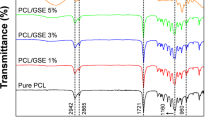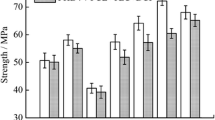Abstract
Biodegradation characteristics of polycaprolactone (PCL) films with three different molecular weights after being degraded by Candida antarctica lipase were investigated. The changes of the PCL films before and after degradation were characterized. The results showed that the degradation process of PCL films could be roughly divided into two phrases: a rapid degradation phase and a slow degradation phase. Molecular weights of PCL films had no influence on the performance of lipase; however, increasing molecular weight caused the numbers of pores on the degraded PCL films to increase, and the pores became deeper as the degradation time increased. The results also showed that the crystallinity of the films decreased with increasing degradation time, and both the crystalline and the amorphous regions of the films were simultaneously degraded. The thermal stability of the films also gradually decreased with the increase of degradation time. Despite the above changes, the degradation did not cause the chemical composition and structure of PCL to change, and PCL remained the main component.






Similar content being viewed by others
References
Aris MH, Annuar MSM, Ling TC (2016) Polym Degrad Stab 133:182–191
Castilla-Cortázar I, Más-Estellésa J, Ivirico JLE, Marí B, Vidaurre A (2012) Polym Degrad Stab 97:1241–1248
Gan Z, Liang Q, Zhang J, Jing X (1997) Polym Degrad Stab 56:209–213
Gulmine JV, Janissek PR, Heise HM, Akcelrud L (2003) Polym Degrad Stab 79:385–397
Karal O, Hamurcu EE, Baysal BM (1997) Polymer 38:6071–6078
Khan I, Dutta JR, Ganesan R (2016) Int J Biol Macromol 95:126–131
Khatiwala VK, Shekhar N, Aggarwal S, Mandal UK (2008) J Polym Environ 16:61–67
McCoy BJ (2001) Chem Eng Sci 56:1525–1529
Mohamed RM, Yusoh K (2016) Adv Mater Res 1134:249–255
Pellis A, Haernvall K, Pichler CM, Ghazaryan G, Breinbauer R, Guebitz GM (2016) J Biotechnol 47:235–241
Saşmazel HT, Gümüşderelioğlu M, Gürpinar A, Onur MA (2008) Biomed Mater Eng 18:119–128
Sekosan G, Vasanthan N (2010) J Polym Sci B 48:202–211
Shi K, Su T, Wang Z (2019) Polym Degrad Stab 164:55–60
Shi K, Jing J, Song L, Su T, Wang Z (2020) Int J Biol Macromol 144:183–189
Sivalingam G, Vijayalakshmi SP, Madras G (2004) Ind Eng Chem Res 43:7702–7709
Tokiwa Y, Suzuki T, Takeda K (1988) Agric Biol Chem 52:1937–1943
Weinberger S, Haernvall K, Scaini D, Ghazaryan G, Zumstein MT, Sander M (2017) Green Chem 19:5381–5384
Weinberger S, Canadell J, Quartinello F, Yeniad B, Arias A, Pellis A, Guebitz GM (2017) Catalysts 7:318
Woodruff MA, Hutmacher DW (2010) Prog Polym Sci 35:1217–1256
Wu D, Yuan L, Laredo E, Zhang M, Zhou W (2012) Ind Eng Chem Res 51:2290–2298
Xie W, Gan Z (2009) Polym Degrad Stab 94:1040–1046
Yin G, Zhang L, Zheng Z, Li QJ (2016) Polym Res 23:229
Acknowledgements
This work was supported by the National Natural Science Foundation of China (Grant No. 31570097), the LiaoNing Revitalization Talents Program (Grant No. XLYC1807034), the Program for Liaoning Innovative Talents in University (Grant No. LR2017063) and the Natural Science Foundation of Liaoning Province (Grant No. 20180550589).
Author information
Authors and Affiliations
Corresponding authors
Additional information
Publisher's Note
Springer Nature remains neutral with regard to jurisdictional claims in published maps and institutional affiliations.
Rights and permissions
About this article
Cite this article
Ma, Q., Shi, K., Su, T. et al. Biodegradation of Polycaprolactone (PCL) with Different Molecular Weights by Candida antarctica Lipase. J Polym Environ 28, 2947–2955 (2020). https://doi.org/10.1007/s10924-020-01826-4
Published:
Issue Date:
DOI: https://doi.org/10.1007/s10924-020-01826-4




